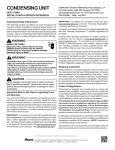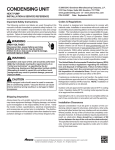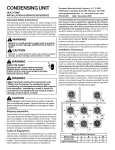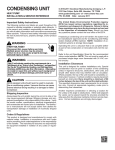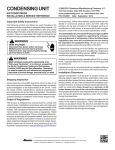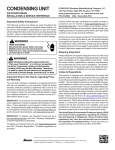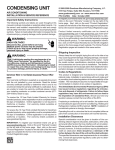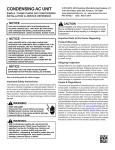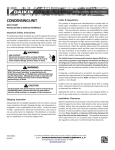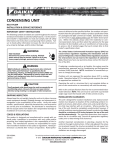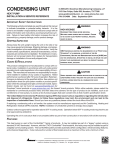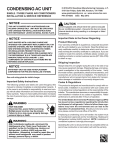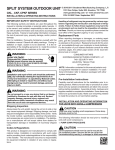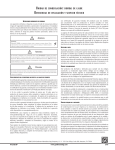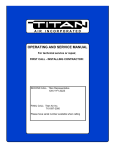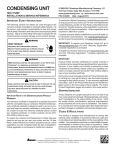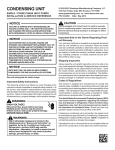Download 1 - Goodman
Transcript
CONDENSING UNIT HEAT PUMP INSTALLATION & SERVICE REFERENCE Important Safety Instructions The following symbols and labels are used throughout this manual to indicate immediate or potential safety hazards. It is the owner’s and installer’s responsibility to read and comply with all safety information and instructions accompanying these symbols. Failure to heed safety information increases the risk of personal injury, property damage, and/or product damage. WARNING HIGH VOLTAGE! Disconnect ALL power before servicing. Multiple power sources may be present. Failure to do so may cause property damage, personal injury or death. Installation and repair of this unit should be performed ONLY by individuals meeting the requirements of an “entry level technician” as specified by the Air Conditioning, Heating and Refrigeration Institute (AHRI). Attempting to install or repair this unit without such background may result in product damage, personal injury or death. CAUTION Scroll equipped units should never be used to evacuate the air conditioning system. Vacuums this low can cause internal electrical arcing resulting in a damaged or failed compressor. © 2005-2010 Goodman Manufacturing Company, L.P. 5151 San Felipe, Suite 500, Houston, TX 77056 www.goodmanmfg.com -or- www.amana-hac.com P/N: IO-259K Date: August 2010 To receive the 10-Year Parts Limited Warranty for Goodman branded products, online registration must be completed within 60 days of installation. Online registration is not required in California or Quebec. Full warranty details available at www.goodmanmfg.com. IMPORTANT: To register your Goodman brand unit, go to www.goodmanmfg.com. Click on the word “Warranty” located on the left side of the home page. Next, click on the word “Product Registration” located on the left side of the Warranty page and complete the forms in the manner indicated on the Product Registration page. To register your Amana brand unit, go to www.amana-hac.com. Click on the word “Warranty” located on the top right of the home page. Next, click on the word “Product Registration” located on the left side of the Warranty page and complete the forms in the manner indicated on the Product Registration page. Product limited warranty certificates for models currently in production can be viewed at www.goodmanmfg.com or www.amana-hac.com. If your model is not currently in production or does not appear on the website, please contact your installing contractor or contact customer service (877254-4729) to obtain a copy of your warranty certificate. Each product overview page contains a Product Warranty link; by clicking on it you will be able to view the limited warranty coverage for that specific product. To view warranty registration information, click on the Product Warranty text on the left navigation panel on the home page of each website. The Online Product Registration pages are located in this same section. Important Note to the Owner regarding Product Warranty Shipping Inspection Your warranty certificate is supplied as a separate document with the unit installed by your contractor. Read the limited warranty certificate carefully to determine what is and is not covered and keep the warranty certificate in a safe place. If you are unable to locate the warranty certificate please contact your installing contractor or contact customer service (877254-4729) to obtain a copy. Always keep the unit upright; laying the unit on its side or top may cause equipment damage. Shipping damage, and subsequent investigation is the responsibility of the carrier. Verify the model number, specifications, electrical characteristics, and accessories are correct prior to installation. The distributor or manufacturer will not accept claims from dealers for transportation damage or installation of incorrectly shipped units. To receive the 10-Year Parts Limited Warranty for Amana branded products, online registration must be completed within 60 days of installation. Online registration is not required in California or Quebec. Full warranty details available at www.amana-hac.com. Codes & Regulations This product is designed and manufactured to comply with national codes. Installation in accordance with such codes and/ or prevailing local codes/regulations is the responsibility of the installer. The manufacturer assumes no responsibility for equipment installed in violation of any codes or regulations. The United States Environmental Protection Agency (EPA) has issued various regulations regarding the introduction and disposal of refrigerants. Failure to follow these regulations may harm the environment and can lead to the imposition of substantial fines. Should you have any questions please contact the local office of the EPA. the unit can vibrate during operation, sound vibration transmission should be considered when installing the unit. Vibration absorbing pads or springs can be installed between the condensing unit legs or frame and the roof mounting assembly to reduce noise vibration. If replacing a condensing unit or air handler, the system must be manufacturer approved and Air Conditioning, Heating and Refrigeration Institute (AHRI) matched. NOTE: Installation of unmatched systems is not allowed. Operating the unit in a structure that is not complete (either as part of new construction or renovation) will void the warranty. NOTE: These units require special location consideration in areas of heavy snow accumulation and/or areas with prolonged continuous subfreezing temperatures. Heat pump unit bases have cutouts under the outdoor coil that permit drainage of frost accumulation. Situate the unit to permit free unobstructed drainage of the defrost water and ice. In more severe weather locations, it is recommended that the unit be elevated to allow unobstructed drainage and air flow. The following elevation minimums are recommended: Installation Clearances Special consideration must be given to location of the condensing unit(s) in regard to structures, obstructions, other units, and any/all other factors that may interfere with air circulation. Where possible, the top of the unit should be completely unobstructed; however, if vertical conditions require placement beneath an obstruction there should be a minimum of 60 inches between the top of the unit and the obstruction(s). The specified dimensions meet requirements for air circulation only. Consult all appropriate regulatory codes prior to determining final clearances. Another important consideration in selecting a location for the unit(s) is the angle to obstructions. Either side adjacent the valves can be placed toward the structure provided the side away from the structure maintains minimum service clearance. Corner installations are strongly discouraged. Design Temperature +15° and above -5° to +14° below -5° Suggested Minimum Elevation 2 1/2" 8" 12" Safe Refrigerant Handling While these items will not cover every conceivable situation, they should serve as a useful guide. WARNING To avoid possible injury, explosion or death, practice safe handling of refrigerants. WARNING NOT RECOMMENDED B B B A Refrigerants are heavier than air. They can "push out" the oxygen in your lungs or in any enclosed space.To avoid possible difficulty in breathing or death: • Never purge refrigerant into an enclosed room or space. By law, all refrigerants must be reclaimed. • If an indoor leak is suspected, throughly ventilate the area before beginning work. • Liquid refrigerant can be very cold. To avoid possible frostbite or blindness, avoid contact and wear gloves and goggles. If liquid refrigerant does contact your skin or eyes, seek medical help immediately. • Always follow EPA regulations. Never burn refrigerant, as poisonous gas will be produced. OK! B AA AA C OK! C AA AA AA A OK! OK! OK! OK! AA AA C Minimum Model Type R esidential Light C ommercial C Airflow C learance A B C 10" 10" 18" 12" 12" 18" WARNING To avoid possible explosion: • Never apply flame or steam to a refrigerant cylinder. If you must heat a cylinder for faster charging, partially immerse it in warm water. • Never fill a cylinder more than 80% full of liquid refrigerant. • Never add anything other than R-22 to an R-22 cylinder or R-410A to an R-410A cylinder. The service equipment used must be listed or certified for the type of refrigerant used. • Store cylinders in a cool, dry place. Never use a cylinder as a platform or a roller. AA 20" 24" This unit can be located at ground floor level or on flat roofs. At ground floor level, the unit must be on a solid, level foundation that will not shift or settle. To reduce the possibility of sound transmission, the foundation slab should not be in contact with or be an integral part of the building foundation. Ensure the foundation is sufficient to support the unit. A concrete slab raised above ground level provides a suitable base. Rooftop Installations If it is necessary to install this unit on a roof structure, ensure the roof structure can support the weight and that proper consideration is given to the weather-tight integrity of the roof. Since 2 WARNING To avoid possible explosion, use only returnable (not disposable) service cylinders when removing refrigerant from a system. • Ensure the cylinder is free of damage which could lead to a leak or explosion. • Ensure the hydrostatic test date does not exceed 5 years. • Ensure the pressure rating meets or exceeds 400 lbs. When in doubt, do not use cylinder. Refrigerant Lines CAUTION The compressor POE oil for R-410A units is extremely susceptible to moisture absorption and could cause compressor failure. Do not leave system open to atmosphere any longer than necessary for installation. Use only refrigerant grade (dehydrated and sealed) copper tubing to connect the condensing unit with the indoor evaporator. After cutting the tubing, install plugs to keep refrigerant tubing clean and dry prior to and during installation. Tubing should always be cut square keeping ends round and free from burrs. Clean the tubing to prevent contamination. Do NOT let refrigerant lines come in direct contact with plumbing, ductwork, floor joists, wall studs, floors, and walls. When running refrigerant lines through a foundation or wall, openings should allow for sound and vibration absorbing material to be placed or installed between tubing and foundation. Any gap between foundation or wall and refrigerant lines should be filled with a pliable silicon-based caulk, RTV or a vibration damping material. Avoid suspending refrigerant tubing from joists and studs with rigid wire or straps that would come in contact with the tubing. Use an insulated or suspension type hanger. Keep both lines separate and always insulate the suction line. These sizes are recommended for line lengths of 79 feet or less to obtain optimum performance. For alternate line sizing options or runs of more than 79 feet, refer to Remote Cooling Service Manual, or TP-107 Long Line Set Application R-410A, or contact your distributor for assistance. Insulation is necessary to prevent condensation from forming and dropping from the suction line. Armflex (or satisfactory equivalent) with 3/8” min. wall thickness is recommended. In severe conditions (hot, high humidity areas) 1/2” insulation may be required. Insulation must be installed in a manner which protects tubing from damage and contamination. Where possible, drain as much residual compressor oil from existing systems, lines, and traps; pay close attention to low areas where oil may collect. NOTE: If changing refrigerant types, ensure the indoor coil and metering device is compatible with the type of refrigerant being used; otherwise, the indoor coil must be replaced. Burying Refrigerant Lines If burying refrigerant lines can not be avoided, use the following checklist. 1. Insulate liquid and suction lines separately. 2. Enclose all underground portions of the refrigerant lines in waterproof material (conduit or pipe) sealing the ends where tubing enters/exits the enclosure. RECOMMENDED INTERCONNECTING TUBING (Ft) 0-24 Cond 25-49 Line Diameter (In. OD) 50-79* Unit Tons Suct Liq Suct Liq Suct Liq 1 1/2 2 2 1/2 3 3 1/2 4 5 5/8 5/8 5/8 3/4 7/8 7/8 7/8 1/4 1/4 1/4 3/8 3/8 3/8 3/8 3/4 3/4 3/4 7/8 1 1/8 1 1/8 1 1/8 3/8 3/8 3/8 3/8 3/8 3/8 3/8 3/4 3/4 7/8 1 1/8 1 1/8 1 1/8 1 1/8 3/8 3/8 3/8 3/8 3/8 3/8 3/8 3. If the lines must pass under or through a concrete slab, ensure lines are adequately protected and sealed. Refrigerant Line Connections IMPORTANT To avoid overheating the service valve, TXV valve, or filter drier while brazing, wrap the component with a wet rag, or use a thermal heat trap compound. Be sure to follow the manufacturer’s instruction when using the heat trap compound. Note: Remove Schrader valves from service valves before brazing tubes to the valves. Use a brazing * Lines greater than 79 feet in length or vertical elevation changes more than 50 feet refer to the Rem ote Cooling Service Manual or contact your distributor for assistance. 3 apply the detector to suspect areas. If leaks are found, repair them. After repair, repeat the pressure test. If no leaks exist, proceed to system evacuation. alloy of 2% minimum silver content. Do not use flux. Torch heat required to braze tubes of various sizes is proportional to the size of the tube. Tubes of smaller size require less heat to bring the tube to brazing temperature before adding brazing alloy. Applying too much heat to any tube can melt the tube. Service personnel must use the appropriate heat level for the size of the tube being brazed. Note: The use of a heat shield when brazing is recommended to avoid burning the serial plate or the finish on the unit. System Evacuation Condensing unit liquid and suction valves are closed to contain the charge within the unit. The unit is shipped with the valve stems closed and caps installed. Do not open valves until the system is evacuated. 1. The ends of the refrigerant lines must be cut square, deburred, cleaned, and be round and free from nicks or dents. Any other condition increases the chance of a refrigerant leak. REFRIGERANT UNDER PRESSURE! Failure to follow proper procedures may cause property damage, personal injury or death. NOTE: Scroll compressors should never be used to evacuate or pump down a heat pump or air conditioning system. 2. “Sweep” the refrigerant line with nitrogen or inert gas during brazing to prevent the formation of copper-oxide inside the refrigerant lines. The POE oils used in R-410A applications will clean any copper-oxide present from the inside of the refrigerant lines and spread it throughout the system. This may cause a blockage or failure of the metering device. CAUTION Prolonged operation at suction pressures less than 20 psig for more than 5 seconds will result in overheating of the scrolls and permanent damage to the scroll tips, drive bearings and internal seal. 3. After brazing, quench the joints with water or a wet cloth to prevent overheating of the service valve. 1. Connect the vacuum pump with 250 micron capability to the service valves. 4. Ensure the filter drier paint finish is intact after brazing. If the paint of the steel filter drier has been burned or chipped, repaint or treat with a rust preventative. This is especially important on suction line filter driers which are continually wet when the unit is operating. 2. Evacuate the system to 250 microns or less using suction and liquid service valves. Using both valves is necessary as some compressors create a mechanical seal separating the sides of the system. 3. Close pump valve and hold vacuum for 10 minutes. Typically pressure will rise during this period. NOTE: Be careful not to kink or dent refrigerant lines. Kinked or dented lines will cause poor performance or compressor damage. 5000 Do NOT make final refrigerant line connection until plugs are removed from refrigerant tubing. VACUUM IN MICRONS 4500 NOTE: Before brazing, verify indoor piston size by checking the piston kit chart packaged with indoor unit. Leak Testing (Nitrogen or Nitrogen-Traced) WARNING 4000 LEAK(S) PRESENT 3500 3000 2500 2000 CONDENSIBLES OR SMALL LEAK PRESENT 1500 To avoid the risk of fire or explosion, never use oxygen, high pressure air or flammable gases for leak testing of a refrigeration system. 1000 NO LEAKS NO CONDENSIBLES 500 WARNING 0 To avoid possible explosion, the line from the nitrogen cylinder must include a pressure regulator and a pressure relief valve. The pressure relief valve must be set to open at no more than 150 psig. 1 2 3 4 5 6 MINUTES 7 8 9 10 • If the pressure rises to 1000 microns or less and remains steady the system is considered leak-free; proceed to startup. • Pressure test the system using dry nitrogen and soapy water to locate leaks. If you wish to use a leak detector, charge the system to 10 psi using the appropriate refrigerant then use nitrogen to finish charging the system to working pressure then 4 If pressure rises above 1000 microns but holds steady below 2000 microns, moisture and/or noncondensibles may be present or the system may have a small leak. Return to step 2: If the same result is encountered check for leaks as previously indicated and repair as necessary then repeat evacuation. To correct, disconnect power and switch any two leads at the unit contactor and re-observe. • If pressure rises above 2000 microns, a leak is present. Check for leaks as previously indicated and repair as necessary then repeat evacuation. High Voltage Connections Route power supply and ground wires through the high voltage port and terminate in accordance with the wiring diagram provided inside the control panel cover. Electrical Connections WARNING Low Voltage Connections HIGH VOLTAGE! Condensing unit control wiring requires 24 Volt minimum, 25VA service from the indoor transformer. Low voltage wiring for twostage units depends on the thermostat used and the number of control wires between the indoor unit and the condensing unit. Route control wires through the low voltage port and terminate in accordance with the wiring diagram provided inside the control panel cover. Disconnect ALL power before servicing. Multiple power sources may be present. Failure to do so may cause property damage, personal injury or death due to electric shock. Wiring must conform with NEC or CEC and all local codes. Undersized wires could cause poor equipment performance, equipment damage or fire. SYSTEM COMPOSITE DIAGRAM HEAT PUMPS 10 KW & BELOW WARNING TYPICAL H/P ROOM THERMOSTAT HEAT PUMP To avoid the risk of fire or equipment damage, use copper conductors. C B L U E W2 O O R A N G E W H I T E Y Y E L L O W R Y O C W2 G R #18 GA. 7 WIRE INDOOR UNIT E R E D R Y NOTICE O Units with reciprocating compressors and non-bleed TXV’s require a Hard Start Kit. SEE NOTE #3 W R R RED G G G GREEN BR W W W2 WHITE BL C BLUE BL BL The condensing unit rating plate lists pertinent electrical data necessary for proper electrical service and overcurrent protection. Wires should be sized to limit voltage drop to 2% (max.) from the main breaker or fuse panel to the condensing unit. Consult the NEC, CEC, and all local codes to determine the correct wire gauge and length. Local codes often require a disconnect switch located near the unit; do not install the switch on the unit. Refer to the installation instructions supplied with the indoor furnace/air handler for specific wiring connections and indoor unit configuration. Likewise, consult the instructions packaged with the thermostat for mounting and location information. R #18 GA. 5 WIRE 2 SEE NOTE #4 1 (OPTIONAL) OUTDOOR THERMOSTAT CLOSE ON TEMPERATURE FALL #18 GA. 6 WIRE NEEDED WHEN OT IS USED SYSTEM COMPOSITE DIAGRAM HEAT PUMPS ABOVE 10 KW TYPICAL H/P ROOM THERMOSTAT HEAT PUMP C B L U E W2 W H I T E O O R A N G E Y Y E L L O W R Y O C W2 G R #18 GA. 7 WIRE INDOOR UNIT E R E D R R Y G O SEE NOTE #3 W 1 2 3 4 • BL BL #18 GA. 5 WIRE The following overcurrent protection devices are approved for use. • Time delay fuses 2 1 OT-1 2 1 OT-2 (OPTIONAL) OUTDOOR THERMOSTAT CLOSE ON TEMPERATURE FALL HACR type circuit breakers NOTES: 1) OUTDOOR THERMOSTAT (OT-1) SHOULD BE THE FIRST TO CLOSE AND THE LAST TO OPEN. 2) CONNECT WHITE AND BROWN WIRES FROM AIRHANDLER TOGETHER IF OT-2 IS NOT USED. 3) REMOVE WIRE WHEN USING OUTDOOR THERMOSTAT 4) TERMINAL BLOCK MARKINGS ARE FOR AMANA AIRHANDLERS. These devices have sufficient time delay to permit the motorcompressor to start and accelerate its load. R RED G G GREEN W W2 WHITE BR W3 BROWN BL C SEE NOTE #2 EHR Overcurrent Protection R BR BLUE SEE NOTE #4 #18 GA. 7 WIRE NEEDED WHEN TWO OT'S ARE USED NOMENCLATURE OT ---OUTDOOR THERMOSTAT (OPTIONAL) EHR -EMERGENCY HEAT RELAY (OPTIONAL) COLOR CODES R --RED Y --YELLOW BL-BLUE BR-BROWN O --ORANGE W -WHITE G --GREEN Thermostat with Low Voltage Wires to Heat Pump Unit Three Phase Compressor Rotation NOTE: For two-stage units, refer to the Installation Instructions supplied with the variable speed indoor units for field wiring connections. CAUTION Use care when handling scroll compressors. Dome temperatures could be hot. System Start Up Three phase compressors are power phase dependent and can rotate in either direction. NOTE: Power must be supplied to the 18 SEER outdoor units containing ECM motors before the power is applied to the indoor unit. Sending a low voltage signal without high voltage power present at the outdoor unit can cause malfunction of the control module on the ECM motor. Verify proper rotation for three phase compressors by ensuring the suction pressure drops and discharge pressure rises when the compressor is energized. NOTE: When operated in reverse, a three phase scroll compressors is noisier and its current draw substantially reduced compared to marked values. 5 Adequate refrigerant charge for a matching evaporator and 15 feet lineset is supplied with the condensing unit. If line set exceeds 15 feet in length, refrigerant should be added at .6 ounces per foot of liquid line. Open the suction service valve first! If the liquid service valve is opened first, oil from the compressor may be drawn into the indoor coil TXV, restricting refrigerant flow and affecting operation of the system. Do not introduce liquid refrigerant from the cylinder into the crankcase of the compressor as this may damage the compressor. 1. Break vacuum by fully opening liquid and suction base valves. 2. Set thermostat to call for cooling. Check indoor and outdoor fan operation and allow system to stabilize for 10 minutes for fixed orifices and 20 minutes for expansion valves. CAUTION Charge Verification POSSIBLE REFRIGERANT LEAK To avoid a possible refrigerant leak, open the service valves until the top of the stem is 1/8” from the retainer. WARNING REFRIGERANT UNDER PRESSURE! When opening valves with retainers, open each valve only until the top of the stem is 1/8” from the retainer. To avoid loss of refrigerant, DO NOT apply pressure to the retainer. When opening valves without a retainer remove service valve cap and insert a hex wrench into the valve stem and back out the stem by turning the hex wrench counterclockwise. Open the valve until it contacts the rolled lip of the valve body. NOTE: These are not back-seating valves. It is not necessary to force the stem tightly against the rolled lip. After the refrigerant charge has bled into the system, open the liquid service valve. The service valve cap is the secondary seal for the valve and must be properly tightened to prevent leaks. Make sure cap is clean and apply refrigerant oil to threads and sealing surface on inside of cap. Tighten cap finger-tight and then tighten additional 1/6 of a turn (1 wrench flat), or to the following specification, to properly seat the sealing surfaces. 1. 3/8” valve to 5 - 10 in-lbs 2. 5/8” valve to 5 - 20 in-lbs 3. 3/4” valve to 5 - 20 in-lbs 4. 7/8” valve to 5 - 20 in-lbs • Do not overcharge system with refrigerant. • Do not operate unit in a vacuum or at negative pressure. Failure to follow proper procedures may cause property damage, personal injury or death. CAUTION Use refrigerant certified to AHRI standards. Used refrigerant may cause compressor damage. Most portable machines cannot clean used refrigerant to meet AHRI standards. NOTICE Violation of EPA regulations may result in fines or other penalties. CAUTION Operating the compressor with the suction valve closed will void the warranty and cause serious compressor damage. SYSTEM SUPERHEAT Indoor W e t Bulb Te m pe ra ture , °F Outdoor Dry Bulb Te m pe ra ture , °F 55 57 59 61 63 65 67 69 71 60 10 13 17 20 23 26 29 30 31 65 8 11 14 16 19 22 26 27 29 70 5 8 10 13 15 19 23 24 25 75 ---- 4 6 9 11 15 20 21 23 80 ---- ---- 1 4 7 12 17 18 20 85 ---- ---- ---- ---- 3 8 13 15 16 90 ---- ---- ---- ---- ---- 5 10 11 13 95 ---- ---- ---- ---- ---- 1 5 8 10 100 ---- ---- ---- ---- ---- ---- 3 5 8 105 ---- ---- ---- ---- ---- ---- ---- 3 5 110 ---- ---- ---- ---- ---- ---- ---- ---- 3 115 ---- ---- ---- ---- ---- ---- ---- ---- 2 6 c. Final Charge Adjustment The outdoor temperature must be 60°F or higher. Set the room thermostat to COOL, fan switch to AUTO, and set the temperature control well below room temperature. After system has stabilized per startup instructions, check subcooling and superheat as detailed in the following section. d. If subcooling and superheat are high, adjust TXV valve to 7 to 9 ºF superheat, then check subcooling. If subcooling is high and superheat is low, adjust TXV valve to 7 to 9 ºF superheat and remove charge to lower the subcooling to 7 ± 2ºF. NOTE: Do NOT adjust the charge based on suction pressure unless there is a gross undercharge. 4. Disconnect manifold set, installation is complete. Fixed Orifice Subcooling Formula = Sat. Liquid Temp. - Liquid Line Temp. CAUTION Two Speed Application Run the remote on low stage cooling for 10 minutes until refrigerant pressures stabilize. Follow the guidelines and methods below to check unit operation and ensure that the refrigerant charge is within limits. Charge the unit on low stage. To prevent personal injury, carefully connect and disconnect manifold gauge hoses. Escaping liquid refrigerant can cause burns. Do not vent refrigerant into the atmosphere. Recover all refrigerant during system repair and before final unit disposal. 1. Purge gauge lines. Connect service gauge manifold to base-valve service ports. Run system at least 10 minutes to allow pressure to stabilize. 1. Purge gauge lines. Connect service gauge manifold to base-valve service ports. Run system at least 10 minutes to allow pressure to stabilize. 2. For best results, temporarily install a thermometer on the suction line near the compressor. The thermometer should be located within 4” to 6” of the compressor. Ensure the thermometer makes adequate contact and is insulated. 2. Temporarily install thermometer on liquid (small) line near liquid line service valve with adequate contact and insulate for best possible reading. NOTE: An optional, less accurate, method is to locate the thermometer at the suction line service valve. Ensure the thermometer makes adequate contact and is insulated. 3. Refer to the superheat table provided for proper system superheat. Add charge to lower superheat or recover charge to raise superheat. 4. Disconnect manifold set, installation is complete. Superheat Formula = Suct. Line Temp. - Sat. Suct. Temp. Expansion Valve System Single Speed Application 1. Purge gauge lines. Connect service gauge manifold to base-valve service ports. Run system at least 10 minutes to allow pressure to stabilize. 3. Check subcooling and superheat. Systems with TXV application should have a subcooling of 5 to 7 ºF and superheat of 7 to 9 ºF. a. If subcooling and superheat are low, adjust TXV to 7 to 9 ºF superheat, then check subcooling. NOTE: To adjust superheat, turn the valve stem clockwise to increase and counter clockwise to decrease. b. If subcooling is low and superheat is high, add charge to raise subcooling to 5 to 7 ºF then check superheat. c. If subcooling and superheat are high, adjust TXV valve to 7 to 9 ºF superheat, then check subcooling. d. If subcooling is high and superheat is low, adjust TXV valve to 7 to 9 ºF superheat and remove charge to lower the subcooling to 5 to 7 ºF. NOTE: Do NOT adjust the charge based on suction pressure unless there is a gross undercharge. 2. Temporarily install thermometer on liquid (small) line near liquid line service valve with adequate contact and insulate for best possible reading. 4. Disconnect manifold set, installation is complete. Subcooling Formula = Sat. Liquid Temp. - Liquid Line Temp. 3. Check subcooling and superheat. Systems with TXV application should have a subcooling of 7 ± 2 ºF and superheat of 7 to 9 ºF. a. If subcooling and superheat are low, adjust TXV to 7 to 9 ºF superheat, then check subcooling. NOTE: To adjust superheat, turn the valve stem clockwise to increase and counter clockwise to decrease. b. If subcooling is low and superheat is high, add charge to raise subcooling to 7 ± 2ºF then check superheat. NOTE: Check the Schrader ports for leaks and tighten valve cores if necessary. Install caps finger-tight. Heat Pump - Heating Cycle The proper method of charging a heat pump in the heat mode is by weight with the additional charge adjustments for line size, line length, and other system components. Make final charge adjustments in the cooling cycle. 7 SATURATED LIQUID PRESSURE TEMPERATURE CHART SATURATED SUCTION PRESSURE TEMPERATURE CHART SUCTION PRESSURE SATURATED SUCTION TEMPERATURE ºF LIQUID PRESSURE SATURATED LIQUID TEMPERATURE ºF PSIG R-22 R-410A PSIG R-22 R-410A 50 26 1 200 101 70 52 28 3 210 105 73 54 29 4 56 31 6 220 225 108 110 76 78 58 60 32 34 7 8 235 113 80 245 116 83 62 35 10 64 37 11 255 265 119 121 85 88 66 68 38 40 13 14 275 124 90 285 127 92 70 41 15 72 42 16 295 305 130 133 95 97 74 76 44 45 17 19 325 137 101 355 144 108 78 46 20 375 148 112 80 48 21 405 155 118 85 50 24 415 157 119 90 53 26 425 n/a 121 95 56 29 100 110 59 64 31 36 435 445 n/a n/a 123 125 475 n/a 130 120 69 41 500 n/a 134 130 73 45 525 n/a 138 140 150 78 83 49 53 550 n/a 142 575 n/a 145 160 86 56 170 90 60 600 625 n/a n/a 149 152 8 Troubleshooting Information Power Failure Blown Fuse Unbalanced Power, 3PH Loose Connection Shorted or Broken Wires Open Fan Overload Faulty Thermostat Faulty Transformer Shorted or Open Capacitor Internal Compressor Overload Open Shorted or Grounded Compressor Compressor Stuck Faulty Compressor Contactor Faulty Fan Relay Open Control Circuit Low Voltage Faulty Evap. Fan Motor Shorted or Grounded Fan Motor Improper Cooling Anticipator Shortage of Refrigerant Restricted Liquid Line Open Element or Limit on Elec. Heater Dirty Air Filter Dirty Indoor Coil Not enough air across Indoor Coil Too much air across Indoor Coil Overcharge of Refrigerant Dirty Outdoor Coil Noncondensibles Recirculation of Condensing Air Infiltration of Outdoor Air Improperly Located Thermostat Air Flow Unbalanced System Undersized Broken Internal Parts Broken Valves Inefficient Compressor Wrong Type Expansion Valve Expansion Device Restricted Oversized Expansion Valve Undersized Expansion Valve Expansion Valve Bulb Loose Inoperative Expansion Valve Loose Hold-down Bolts Faulty Reversing Valve Faulty Defrost Control Faulty Defrost Thermostat Flowrator Not Seating Properly • • • • • • • • • • • • • • • • • • • • • • • • • • • ♦ ♦ • • Test Voltage Inspect Fuse Size & Type Test Voltage Inspect Connection - Tighten Test Circuits With Ohmmeter Test Continuity of Overload Test Continuity of Thermostat & Wiring Check Control Circuit with Voltmeter Test Capacitor Test Continuity of Overload Test Motor Windings Use Test Cord Test Continuity of Coil & Contacts Test Continuity of Coil And Contacts Test Control Circuit with Voltmeter Test Voltage ♦ Repair or Replace Test Motor Windings Check Resistance of Anticipator Test For Leaks, Add Refrigerant Remove Restriction, Replace Restricted Part Test Heater Element and Controls ♦ Inspect Filter-Clean or Replace ♦ Inspect Coil - Clean ♦ Check Blower Speed, Duct Static Press, Filter Reduce Blower Speed ♦ Recover Part of Charge Inspect Coil - Clean ♦ Recover Charge, Evacuate, Recharge Remove Obstruction to Air Flow Check Windows, Doors, Vent Fans, Etc. Relocate Thermostat Readjust Air Volume Dampers Refigure Cooling Load Replace Compressor Test Compressor Efficiency Test Compressor Efficiency ♦ Replace Valve Remove Restriction or Replace Expansion Device Replace Valve Replace Valve Tighten Bulb Bracket Check Valve Operation Tighten Bolts ♦ ♦ ♦ ♦ Replace Valve or Solenoid ♦ ♦ ♦ ♦ Test Control ♦ ♦ ♦ ♦ ♦ Test Defrost Thermostat Check Flowrator & Seat or Replace Flowrator Heating Cycle Only (Heat Pump) • • • • • • • ♦ • • • • • • • • • • • • • • • • • • • • • • • • • • • • • • • • • • • • • • • • • • • • • • • • • • • ♦ ♦ ♦ ♦ • • • • • • • • • • • • • • • • • • • • ♦ ♦ ♦ ♦ ♦ ♦ ♦ ♦ Cooling or Heating Cycle (Heat Pump) • • • • • • • • ♦ Test Method Remedy High head pressure High suction pressure Low head pressure Low suction pressure Unit will not defrost Unit will not terminate defrost System runs - blows cold air in heating Compressor is noisy Certain areas too cool, others too warm Not cool enough on warm days Too cool and then too warm System runs continuously - little cooling/htg • • • • • • • • • • • Compressor cycles on overload • • • • • • • System Operating Pressures Unsatisfactory Cooling/Heating Compressor runs - goes off on overload Condenser fan will not start Evaporator fan will not start Compressor will not start - fan runs SYMPTOM DOTS IN ANALYSIS GUIDE INDICATE "POSSIBLE CAUSE" System will not start POSSIBLE CAUSE Comp. and Cond. Fan will not start No Cooling Complaint • • For detailed service information refer to the Remote Condensing Unit Service manual. NOTICE Units with rotary or reciprocating compressors and non-bleed TXV’s require a Hard Start Kit. 9 THIS PAGE LEFT INTENTIONALLY BLANK 10 THIS PAGE LEFT INTENTIONALLY BLANK 11 Goodman Manufacturing Company, L.P. 5151 San Felipe, Suite 500, Houston, TX 77056 www.goodmanmfg.com © 2005-2010 Goodman Manufacturing Company, L.P. 12












